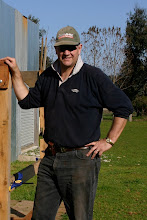Last Monday was said to be the second worst day in terms of risk - after the terrible Saturday when the lives were lost. In mid afternoon a fire started about 10 km to the south west of our McKerrels tree farm. It is at Grenville 20 km south of Ballarat. The fire started in the worst possible place for us - just ahead of a south westerly wind change. Within an hour or two it had been 'controlled'. Thank heavens - there were only blue gum plantations between the fire and an important component of our superannuation.
 Back now to the search for economic relevance for Moora. Here is where we have got to.
Back now to the search for economic relevance for Moora. Here is where we have got to.The next thing to look at is the means by which most small farmers take a living from a limited land base - and that is by growing vegetables- and, in time, fruit. I approach this with some trepidation because I know, by reputation, the plain hard work involved with vegetable growing at any scale.
I've grown vegetables on a hobby or 'feed the family' basis for 35 years, but my only attempt at a commercial venture was as a 15 year old when I grew pumpkins in the Pretty Paddock at home. We got a good crop - but a good crop when everyone else had one meant low prices. We put them aside in a corner of George's Whare - where most rotted before we sold the good ones for, as I recall it, not very much.
I've grown vegetables on a hobby or 'feed the family' basis for 35 years, but my only attempt at a commercial venture was as a 15 year old when I grew pumpkins in the Pretty Paddock at home. We got a good crop - but a good crop when everyone else had one meant low prices. We put them aside in a corner of George's Whare - where most rotted before we sold the good ones for, as I recall it, not very much.
The type of vegetable farming that interests me most is growing a wide range of vegetables to a Community Supported Agriculture (CSA) mode. In a CSA customers are asked to become, in effect, partners in the enterprise - by subscribing to a season's worth of vegetables in advance. The produce is then delivered in a 'box' on a weekly basis over about 30 weeks. The idea appears to have at least 2 sources - in Japan and the also in Europe tied up in some way with Rudolf Steiner.
There are some examples in Australia - but I'm still at the early stages of learning about them. Suffice for the purposes of this blog to note that we have the site(s) to grow the 30 to 50 vegetable / fruit varieties that go into a typical CSA box over the course of a season - and we have the ability to water them to keep them growing.

The photo shows the relocated garage that will be the base from which the vegetable enterprise works. Behind the shed is an area of over half an acre that is already laid out as a big garden. I've planted cypress trees to shelter the area from the winds that sweep in from the right of the photo.
At the bottom of the hill is an area where we can grow more crops - on a more extensive basis. There is other space around to the left of this photo. In all there is at least 4 acres that can be intensively farmed.
Labour is going to be the big issue. Commercial vegetable growing needs lots of work - and lots of bending, lifting, twisting, bumping - and then more of the same the following day. Joel Salatin points out that older farmers don't need to do everything themselves - that they can co-venture with younger people in need of access to land.
In any case, I think it's not unrealistic to say that a mature CSA enterprise could have 100 'shares' at $600 pa - that's another 10 squares.

We're getting close - at least in theory. And there can be a lot of difference between theory and reality - let's talk about that in the next post.




No comments:
Post a Comment